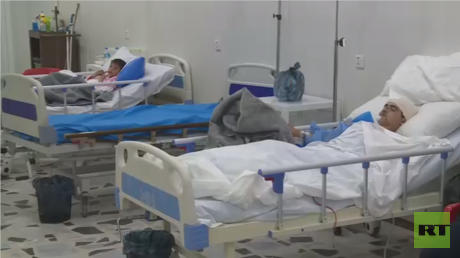Price of liberation: Civilian exodus, bombed-out streets filmed by RT in Mosul (VIDEO)
RT’s Murad Gazdiev and his crew have filmed parts of western Mosul roughly one kilometer from the frontline between the US-backed coalition and Islamic State (IS, previously ISIS/ISIL). Though the area is now considered to be liberated from IS, it looks like no man’s land, scorched and carpet-bombed.
US-backed Iraqi government forces launched a major offensive in February to recapture the western part of Mosul, where IS still controls sizeable pockets of territory. Supported by airstrikes, they are making their way through Islamic State’s major urban stronghold in Iraq, but at a horrible civilian cost.
Despite the coalition’s repeated assurances that it is taking every precaution when carrying out its airstrikes, the fighting has badly damaged many homes, shops, and other buildings, which now bear scars inflicted by heavy weapon fire.
The physical appearance of civilians being driven out of their neighborhoods by Iraqi soldiers in armored vehicles and trucks provides telling evidence of what they have been through during the anti-IS operation. “Dirty clothes, dust-covered faces – the obvious signs of people who had been through too much,” Murad noted.
Notably, evacuating civilians from the liberated areas of western Mosul is no easy task, as some important crossroads have been intentionally bombed to prevent Islamic State commanders from moving reinforcements and supplies, leaving them unpassable. Consequently, vehicles are not able to deliver medical aid or food along many of the roads.
Walking through west Mosul, the RT crew noticed that almost every door had been kicked in and almost every shop broken into.
#Mosul, #Iraq. 1km from ISIS positions https://t.co/FmKVTE3RFz
— Murad Gazdiev (@MuradGazdiev) March 20, 2017
Goods and possessions were seen lying in the streets, suggesting that nearby houses had been looted. “But, there’s no one left to complain,” Murad added, as his crew filmed people moving slowly down the street, apparently leaving the city. However, some residents have chosen to stay to protect their property or are simply unwilling to flee.
The grim picture of devastation and suffering witnessed by RT’s crew matches the predictions of aid agencies.
On Sunday, an RT crew also visited a medical center set up by the DARY humanitarian organization in Mosul, to film an eight-year-old girl named Duua who was lucky to survive an airstrike in the city's Jadeda neighborhood. Both of her parents and other family members are believed to have been killed in the strike, and the camp’s founder said the girl was found on a street, lying there with heavy injuries.
“In the last 12 days, there has been constant rocket fire,” a local resident also told RT. “Yesterday it lasted from seven in the morning until four in the afternoon. Thirty or 40 houses have been damaged, and there are hundreds of casualties.”
According to the latest estimates from the UN refugee agency, UNHCR, up to 300,000 people may flee western Mosul in a fresh wave that could overwhelm the organization’s capacity to accommodate those displaced.
In early March, the UNHCR said about 192,000 residents had fled Mosul since October of last year, while about 750,000 still remained. Other UN figures suggest 5,000 people on average have been fleeing the city every day since the siege intensified in February.
